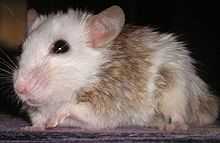Southern multimammate mouse
| Southern Multimammate Mouse | |
|---|---|
 | |
| Conservation status | |
| Scientific classification | |
| Kingdom: | Animalia |
| Phylum: | Chordata |
| Class: | Mammalia |
| Order: | Rodentia |
| Family: | Muridae |
| Genus: | Mastomys |
| Species: | M. coucha |
| Binomial name | |
| Mastomys coucha (Smith, 1834) | |
The Southern Multimammate Mouse (Mastomys coucha) is a species of rodent in the family Muridae. It is found in Angola, Botswana, Lesotho, Mozambique, Namibia, South Africa, and Zimbabwe. Its natural habitats are dry savanna, moist savanna, subtropical or tropical dry shrubland, arable land, and rural gardens.
Identification
M. coucha is sympatric with Mastomys natalensis and is only definitively identified by karyotyping or DNA sequencing. Many academic labs and publicly available animals were derived from a colony originally misidentified as M. natalensis.[1]
Domestication
The Southern multimammate rat is currently being bred in the US and Canada as a replacement food source for reptiles, replacing the brown rat as a viable food source for picky eaters. It is also recognized as one of the natural food sources for ball pythons. They are also being used for stomach cancer research, among other ailments. Europeans have begun breeding them for companion animal use, namely in Germany and England. This trend is also catching, slowly, in the US and Canada.
They thrive in small breeding colonies, but chew on anything they can reach. Thus regular rat rack systems do not work; 10 gallon glass fish tanks work best. Also glass water bottles are needed. They have litters of 10-20 babies monthly, and reach sexual maturity at around three months of age.
Only recently has it been introduced to the pet trade, and is more often kept as a feeder rodent for snakes than as a pet.
References
Further reading
- Coetzee, N., Griffin, M. & Granjon, L. 2004. Mastomys coucha. 2006 IUCN Red List of Threatened Species. Downloaded on 19 July 2007.
- Musser, Guy G.; Carleton, Michael D. (2006). "Superfamily Muroidea". In Wilson, Don E.; Reeder, DeeAnn M. Mammal Species of the World: A Taxonomic and Geographic Reference. Baltimore: Johns Hopkins University Press. pp. 894–1531. ISBN 978-0-8018-8221-0.
- Haag, Andreas; Wayss, Klaus; Rommelaere, Jean; Cornelis, Jan (2000). "Experimentally induced infection with autonomous parvoviruses, minute virus of mice and H-1, in the African multimammate mouse (Mastomys coucha)". Comparative Medicine 50 (6): 613–21. PMID 11200567.
- Vinzón, Sabrina E.; Braspenning-Wesch, Ilona; Müller, Martin; Geissler, Edward K.; Nindl, Ingo; Gröne, Hermann-Josef; Schäfer, Kai; Rösl, Frank (2014). "Protective Vaccination against Papillomavirus-Induced Skin Tumors under Immunocompetent and Immunosuppressive Conditions: A Preclinical Study Using a Natural Outbred Animal Model". PLoS Pathogens 10 (2): e1003924. doi:10.1371/journal.ppat.1003924. PMID 24586150.
- Lütkefels, Elke Maria Hermine (2003). Licht- und elektronenmikroskopische Untersuchungen von Lunge und Pleura der mit Litomosoides sigmodontis infizierten Mastomys coucha [Histopathological and electron microscopical studies of lung and pleura in Litomosoides sigmodontis infected Mastomys coucha] (Dissertation) (in German). University of Giessen.
